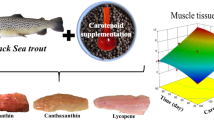Abstract
Chlorine dioxide (CIO2) has been explored as a potential substitute for aqueous chlorine to clean seafood products. In an attempt to understand the interaction of CIO2 with organic compounds, duplicate fillets of Atlantic salmon (Salmo salar) and red grouper (Epinephelus morio) were treated for 5 min with freshly prepared aqueous CIO2 at 20, 40, 100, and 200 ppm total available CIO2 in 3.5% brine. Thiobarbituric acid (TBA) values and fatty acid composition were determined. CIO2-treated salmon and red grouper showed a dose-related increase in TBA; the 100 and 200 ppm groups had significantly (P<0.05) greater TBA values than controls and the 20 ppm group. Treated red grouper and salmon did not differ in percentage monounsaturated and polyunsaturated fatty acids compared to controls, although differences occurred with some individual fatty acids. Thus, CIO2 treatment did not greatly affect fatty acid composition of treated fillets.
Similar content being viewed by others
References
Freese, R., M. Mutanen, L.M. Valsta, and I. Salminen, Comparison of the Effects of Two Diets Rich in Monounsaturated Fatty Acids Differing in Their Linoleic/α-Linolenic Acid Ratio on Platelet Aggregation, Thromb. Haemostas. 71:73–77 (1994).
Harris, W.S., Fish Oils and Plasma Lipid and Lipoprotein Metabolism in Humans: A Critical Review, J. Lipid Res. 30:785–807 (1989).
Stansby, M.E., Properties of Fish Oils and Their Application to Handling of Fish and to Nutritional and Industrial Use, in Chemistry and Biochemistry of Marine Food Products, edited by R.E. Martin, G.J. Flick, C.E. Heberd and D.R. Ward, Avi, Westport, 1982, pp. 75–92.
Lillard, H.S., Levels of Chlorine and Chlorine Dioxide of Equivalent Bactericidal Effect in Poultry Processing Water, J. Food Sci. 44:1594–1597 (1979).
Ghanbari, H.A., W.B. Wheeler, and J.R. Kirk, Reactions of Aqueous Chlorine and Chlorine Dioxide with Lipids: Chlorine Incorporation, J. Food Sci. 47:482–485 (1982).
Standard Methods for the Examination of Water and Wastewater, 17th edn., American Public Health Association, Washington, D.C., 1989, Method 4500.
Tarladgis, B.G., B.M. Watts, and M.T. Younathan, A Distillation Method for the Quantitative Determination of Malonaldehyde in Rancid Foods, J. Am. Oil Chem. Soc. 37:44–48 (1960).
Folch, J., M. Lees, and G.H. Sloane Stanley, A Simple Method for the Isolation and Purification of Total Lipids from Animal Tissues, J. Biol. Chem. 226:497–509 (1957).
Christie, W.W., Lipid Analysis: Isolation, Separation, Identification and Structural Analysis of Lipids, Pergamon Press, Oxford, 1982, p. 22.
Maxwell, R.J., and W.N. Marmer, Fatty Acid Analysis: Phospholipid-Rich Analysis, Lipids 18:453–459 (1983).
Ackman, R.G., Application of Gas-Liquid Chromatography to Liquid Separation and Analysis: Qualitative and Quantitative Aspects. Chapter 16, in Analysis of Fats, Oils and Lipoproteins, edited by E.G. Perkins, American Oil Chemists’ Society, Champaign, 1991.
SAS Institute, Inc., SAS/STAT Guide for Personal Computers, Statistical Analysis Systems Institute, Cary, 1985, pp. 183–260.
Ke, P.J., R.G. Ackman, B.A. Linke, and D.M. Nash, Differential Lipid Oxidation in Various Parts of Frozen Mackerel, J. Food Technol. 12:37–47 (1977).
Coppock, J.B.M., N.W.R. Daniels, and P.W. Russell Eggitt, Essential Fatty Acid Retention in Flour Treatment, Chemistry and Industry 1:17–18 (1960).
Moran, T., J. Pace, and E.E. McDermott, Interaction of Chlorine Dioxide with Flour: Certain Chemical Aspects, Nature 171:103–106 (1953).
Meredith, P., H.G. Sammons, and A.C. Frazer, Studies on the Effects of Treatment with Chlorine Dioxide on the Properties of Wheat Flour, J. Sci. Food Agric. 7:361–370 (1956).
Author information
Authors and Affiliations
About this article
Cite this article
Kim, J., Lee, Y., O’Keefe, S.F. et al. Effect of chlorine dioxide treatment on lipid oxidation and fatty acid composition in salmon and red grouper fillets. J Amer Oil Chem Soc 74, 539–542 (1997). https://doi.org/10.1007/s11746-997-0177-y
Received:
Accepted:
Issue Date:
DOI: https://doi.org/10.1007/s11746-997-0177-y




